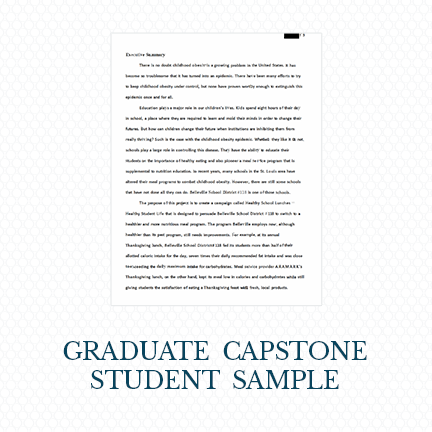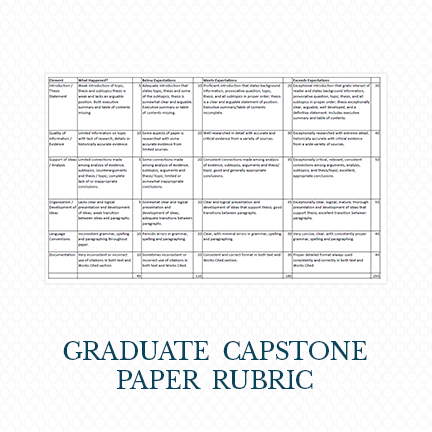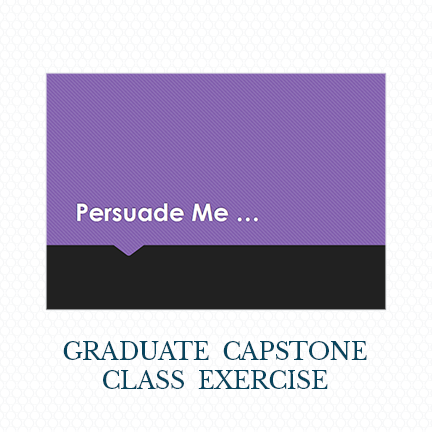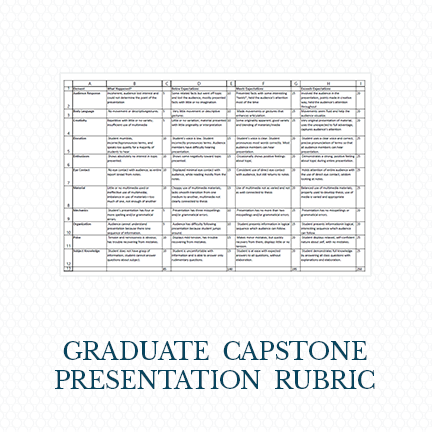“This course was great – it really encompassed everything I have learned throughout the Master’s program.”
“Great discussions! The instructor was very helpful and knowledgeable. We agreed that we learned more from Danielle Oser than most of our other instructors.”
“Similar to previous cluster with teacher. We knew what to expect and she knew us well. Having consistency helps. Best teacher I took though my program. Required student interaction and involvement in class.”
“This course was taught with a hands-on approach, instead of the traditional lecture. Class involvement, discussions and routine presentations helped made this course one to look forward to. Any student who has the privilege of meeting Danielle Oser is in for a treat!”
Description
This course develops and advances presentation skills and business etiquette as it applies in various communication settings in all career and project development phases. Students are expected to select a project important to their intellectual and professional development in communications skills and apply appropriate assessment criteria to various presentation styles and formats through all phases of the capstone project.
This course is primarily an examination of persuasion. We will examine persuasion from various perspectives and consider how the target, the techniques, the source, the message, and the communication channel all interplay in persuasion.
- Target: Any persuasion attempt must consider the characteristics of the target. A successful persuasion attempt directed at one population subgroup may fail when applied to a different subset.
- Techniques: There are a variety of techniques available for any persuasion attempt. Knowing when and how to use these techniques effectively is central to any persuasion attempt.
- Source: Persuasion attempts can originate from various sources (e.g., parents, friends, government, and business). What characteristics of a source are typical within successful persuasion attempts?
- Message: Although the content conveyed in different persuasion attempts will change, some features can be utilized within a message to improve the effectiveness of persuasion attempts.
- Channel: There are multiple methods to reach a persuasion target (e.g., print, word of mouth, the internet). We will examine the strengths and weaknesses of different channels.
Objectives
The courses offered by the program are designed to support one or more of the following student learning outcomes:
- Demonstrate effective written communication and documentation skills.
- Demonstrate practical oral communication skills.
- Knowledge of critical issues, ideas, trends, and practitioners in the communication discipline.
- Apply fundamental theories and critical thinking skills to creative and organizational projects and activities in the media and corporate communication industries.
- Demonstrate various technical skills and aesthetic choices appropriate for use in mass media and corporate communication.
- Differentiate between ethical and unethical communication choices in corporate and media industries
Persuasion is a dynamic and developing discipline. Persuasion techniques of one hundred or even five years ago differ from effective persuasion techniques utilized today. This is due to a variety of reasons. Still, our understanding of persuasion has evolved, the target of persuasion techniques (us) has changed over the years, and finally, new channels for persuasion (e.g., the internet) are now available. However, there are still many vital lessons and practical techniques to be learned from past studies. This course will, therefore, examine past and current persuasion techniques. This course aims to educate you regarding a selection of persuasion attempts many of you are exposed to daily. A practical first step in persuading others is to identify the persuasion attempts others are directing at you
When you have completed this course, you should be able to:
- Identify persuasion attempts by individuals and organizations.
- Understand how different persuasion attempts manipulate people.
- Improve your ability to resist persuasion techniques.
- Understand how persuasion differs across subgroups (e.g., gender and cultures).
- Understand the relationship between behavior and attitude.
- Utilize persuasion more effectively in your own day-to-day lives.
- Employ persuasion techniques to improve the effectiveness of campaigns.
Instructional Methods
- Capstone Project: The capstone project will provide evidence of your ability to conduct secondary research and to synthesize various pieces of information, ideas and concepts into a coherent, persuasive argument. Your topic is critical to developing your capstone project. It is impossible to create a successful project with a poorly chosen topic. While it is hard to say how a good topic should be selected or developed, we can notice that choosing a subject you already know something about helps tremendously. The best issues are likely to be derived from topics treated in a class you have had in your communications emphasis. You may also find it helpful to approach it by thinking that if you were responsible for improving a particular problem or issue at your present place or hoped-for place of employment, how would you propose resolving it? The final project in the form of a paper/proposal is intended for you to examine a communications issue or problem in your area of emphasis (Digital and Multimedia Studies, Training and Development, Promotions, or Media Management) and persuasively propose a recommended solution that will improve or resolve the current situation. You should also plan on incorporating technologies (systems or processes) available to professional communicators today, if possible. Your project will be 25 to 30 pages in length. The paper must use in-text citations, and works cited consistent with MLA guidelines. It should include the following major elements:
- Executive Summary, Thesis statement, Situation analysis. Describe the problem’s cause and the actual or potential impact on an organization, Social Behavioral Project, What needed future improvements do you recommend to address the issue or problem? Evidence to support your proposal, including emotional evidence (appeals, what benefits will be derived from your project?
- First Assignment: This assignment will be most effective for your personal growth if you do each part in sequence. You must also do a first draft of the whole assignment and then let it sit for several days while you re-think some of your answers. Your final draft should have some substantial changes from your first draft. All responses will be kept confidential unless the student wishes to share them with others.
- Develop a one-page autobiographical outline featuring significant events in your life.
- Write a 3-5 page autobiography.
- List your undergraduate major and the clusters you have taken at the graduate level.
- Write a one-page description of why you decided to pursue your Master’s degree, what your expectations were for your graduate education when you started, and your evaluation of your graduate education to this point.
- Develop a list of the ten most important accomplishments you would like to complete throughout your lifetime. Then rank them in order of importance.
- Develop your professional plan. What are your professional goals and expected accomplishments?
- Be prepared to tell a short, 3 to the 5-minute story about yourself to your classmates during the first class session. Your objective should be to engage your audience and make a personal, emotional connection. Emotional appeals can be humorous, sad, angry, patriotic, joyous, achievement-oriented, prideful, family-oriented, and many others.
- Chapter Presentation: Each class member will prepare a presentation of an assigned chapter from Influence. The presentations must clearly outline and explain the book’s central concepts without reading directly from Cialdini. The idea of the presentation is for you to reflect on and offer other applications of Cialdini’s concepts than what you find in the text. The resulting presentation will be a concise study aid and “real life” supplement to Cialdini. Most importantly, you must include examples and explorations of your own: they cannot restate the text examples. This is your chance to bring in samples from the world around us — persuasion in action. These samples can include activities, videos, handouts, and games — let your imagination run wild. I am looking for clarity of content as well as creativity. Your presentation should also include at least three discussion questions to engage your audience in the presentation (i.e., asking them if they have had a particular experience or if they have ever encountered a specific behavior). These questions will provide post-presentation discussion for the class. When you post your presentation, you will also submit, in a separate document, three suggested multiple-choice exam questions with the answers.
- Social-Behavioral Project: You will conduct an experiment employing a theory from the class persuasive theory content. You may work alone or with a partner to develop and execute an investigation. The project will include a 5-6 page paper discussing your research process/findings and a presentation of your results. The paper must include at least three academic research articles (preferably not websites) of similar research already done in the field. You must analyze how your results compare to the samples you present.







